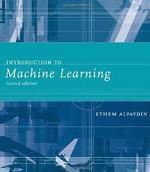
NEWS: Chatbots.org survey on 3000 US and UK consumers shows it is time for chatbot integration in customer service!read more..
Machine Learning
Introduction to

The goal of machine learning is to program computers to use example data or past experience to solve a given problem. Many successful applications of machine learning exist already, including systems that analyze past sales data to predict customer behavior, optimize robot behavior so that a task can be completed using minimum resources, and extract knowledge from bioinformatics data. The second edition of Introduction to Machine Learning is a comprehensive textbook on the subject, covering a broad array of topics not usually included in introductory machine learning texts. In order to present a unified treatment of machine learning problems and solutions, it discusses many methods from different fields, including statistics, pattern recognition, neural networks, artificial intelligence, signal processing, control, and data mining. All learning algorithms are explained so that the student can easily move from the equations in the book to a computer program. The text covers such topics as supervised learning, Bayesian decision theory, parametric methods, multivariate methods, multilayer perceptrons, local models, hidden Markov models, assessing and comparing classification algorithms, and reinforcement learning. New to the second edition are chapters on kernel machines, graphical models, and Bayesian estimation; expanded coverage of statistical tests in a chapter on design and analysis of machine learning experiments; case studies available on the Web (with downloadable results for instructors); and many additional exercises. All chapters have been revised and updated. Introduction to Machine Learning can be used by advanced undergraduates and graduate students who have completed courses in computer programming, probability, calculus, and linear algebra. It will also be of interest to engineers in the field who are concerned with the application of machine learning methods.
New Comment
Only registered members are allowed to comment. or login
or login
